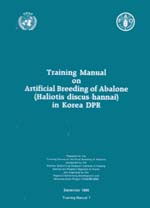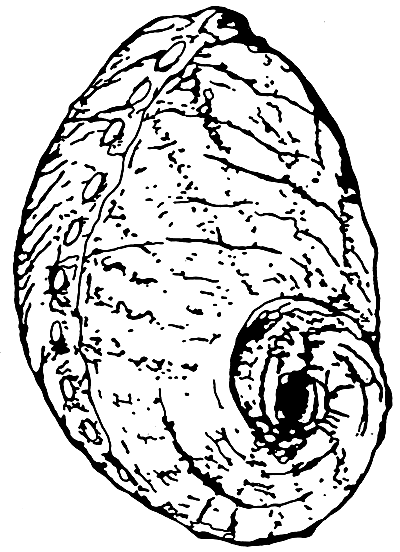
on
Artificial Breeding of Abalone
(Haliotis discus hannai)
in Korea DPR
 |
Training Manual on Artificial Breeding of Abalone (Haliotis discus hannai) in Korea DPR |
 |  |
Prepared for the
Training Course on Artificial Breeding of Abalone
conducted by the
Shallow Seafarming Research Institute in Kosong
Democratic People's Republic of Korea
and organized by the
Regional Seafarming Development and
Demonstration Project (RAS/90/002)
September 1990
Training Manual 7
Abalone can be considered as one of the gastropods that have a high potential for commercial exploitation in the Asia-Pacific region. They command a high price and are highly relished in a number of Asian countries, particularly in China, Japan, and the Koreas. In these countries, the technology for breeding and culturing abalone are now relatively advanced. However, in the sub-tropical and tropical countries, breeding work is generally confined to laboratory trials, and the little production that has been reported mostly come from gathering.
There are in these countries suitable species that have a good economic potential for commercial breeding and culture. This has been shown in surveys conducted in Thailand and reports of limited production from the Philippines, India, Indonesia and the other tropical countries in the region. Thus, the dissemination of the breeding and culture technology already well developed and routinely practiced in the northern East Asian countries would contribute to the expansion of the development of abalone culture in the whole region. It is towards this objective that the training course on the breeding and culture of abalone was planned and designed.
The course was proposed by the National Coordinators of the UNDP/FAO Regional Seafarming Development and Demonstration Project (RAS/86/024, presently RAS/90/002). It is to be implemented by the Government of the Democratic People's Republic of Korea (DPRK) through its Shallow Seafarming Research Institute in Kosong, which is a nodal centre of the Seafarming Project and now part of the Network of Aquaculture Centres in Asia and the Pacific. The Institute is also being strengthened by an UNDP/FAO assistance project. The staff of the Institute wrote this training manual. It was edited and produced by the staff of the Seafarming Project office in Bangkok.
It is hoped that this training course as well as the information contained in this manual will stimulate the development of abalone culture in many countries thus contributing further to the expanded development of seafarming as well as aquaculture in the region.
| Regional Seafarming Development and Demonstration Project |
|
| (RAS/90/002) | |
| July 1990 |

Hyperlinks to non-FAO Internet sites do not imply any official endorsement of or responsibility for the opinions, ideas, data or products presented at these locations, or guarantee the validity of the information provided. The sole purpose of links to non-FAO sites is to indicate further information available on related topics.
This electronic document has been scanned using optical character recognition (OCR) software. FAO declines all responsibility for any discrepancies that may exist between the present document and its original printed version.
PART I
BIOLOGY AND CULTURE OF ABALONE
Chapter I
Species and their geographical distribution
2.2.3 The respiratory and circulation systems
Chapter III
Reproduction and growth of abalone
3.3 Oxygen consumption of abalone
3.4.1 Free swimming and setting stages
3.4.2 Juvenile and adult stages
Chapter IV
Preparation of spawners
Chapter V
Maturation of spawners
Chapter VII
Fertilization and egg washing
8.1 Free-swimming larvae culture
Chapter X
Intermediate culture
11.2 Preparation of the culture site
11.4 Release of abalones into the sea
Chapter XII
The production of abalone
PART II
CULTIVATION OF LIVE FOOD AND WATER
QUALITY CONTROL TECHNIQUES
Chapter I
Cultivation of live food
1.1 Collection of benthic diatoms
1.1.1 From polyethylene plates or plastic floats
1.1.3 From gravel or bivalve shells
1.2 Diatom settlement on feeding plates
1.3 Management of diatoms rearing conditions
1.4 Growth and culture of diatoms
1.5 Diatoms as young abalone feed
Chapter II
Water quality control
2.1.2 Filtering micro-organisms
2.2 Critical factors in water purification
2.2.1 Maturation of the filter media
2.2.2 Bacteria formation in the filter media
2.2.3 Filter media quality and bacteria number
2.2.4 Condition favourable for bacteria activity
2.3 Synthetic resin filter media
2.3.1 Synthetic resin and other filter media
2.3.2 Purifying ability of synthetic resin
2.4 Water quality control in a circulating filtration rearing system
Chapter III
Design of filter tanks
3.1 Norms for designing filter tanks
3.1.1 In respect of oxidation rate of ammonia
3.1.2 Dissolved oxygen reduction during filtration
3.2 Factors affecting level of dissolved oxygen (DO)
3.2.1 Food level and DO consumption
3.2.2 DO consumption per unit surface area of filter medium
3.2.3 Depth of a filter medium
3.4 Efficiency of a filter tank
Chapter IV
Measurement of standard values in water quality control
4.4 Biochemical Oxygen Demand (BOD)
4.5 Chemical Oxygen Demand (COD)
PART III
BREEDING OF ABALONE: PRACTICAL EXERCISES
Practical I
Appearance and internal structures of abalone (Haliotis
discus hannai Ino)
Practical II
Preparation of adult abalone
Practical III
Broodstock conditioning
Practical V
Egg fertilization and early embryo handling
Practical VI
Rearing of free-swimming larvae
Practical VII
Rearing of juvenile abalone
Practical VIII
Intermediate rearing
ARTIFICIAL BREEDING OF ABALONE
IN THE DEMOCRATIC PEOPLE'S REPUBLIC OF KOREA
Abalones have been long considered as a valuable fishery product. From as far back as 1880 until 1952, studies were mainly focussed on its habitat, taxonomy, spawning season, breeding, feeding habits, and growth. Throughout this period studies were also concentrated on artificial propagation and rearing methods suitable for selected areas, as well as on transplanting and releasing adult abalones to potential on-growing sites.
In the 1960's, on the basis of successful seed rearing experiments, studies were conducted with the view to produce seeds on an industrial scale. These studies, eventually succeeded in the establishment of a seed production system.
Maritime countries have given priority to aquaculture development with the objective of preserving and increasing their natural resources. It is in line with this aim that the Democratic People's Republic of Korea (DPRKorea) has embarked on an intensified development of numerous aquatic resources. The suggested method of abalone culture is to release hatchery-bred juveniles into natural waters and allow them to grow mainly on natural feed organisms. This method fully considers the fact that it takes 3 to 4 years for abalones to attain the desired marketable size. However, due to the increasing demand of the high valued gastropod, a number of land-based intensive farming techniques have been developed.